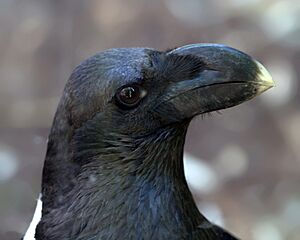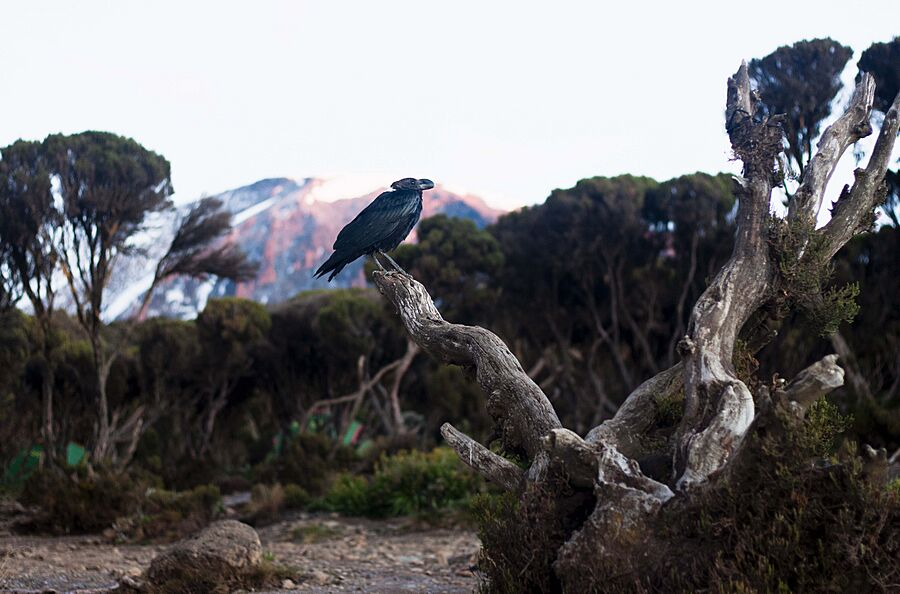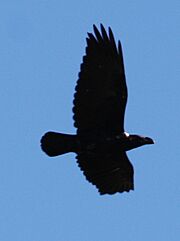White-necked raven facts for kids
Quick facts for kids White-necked raven |
|
|---|---|
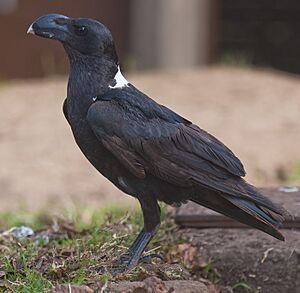 |
|
| From Ngorongoro Conservation Area | |
| Conservation status | |
| Scientific classification | |
| Genus: |
Corvus
|
| Species: |
albicollis
|
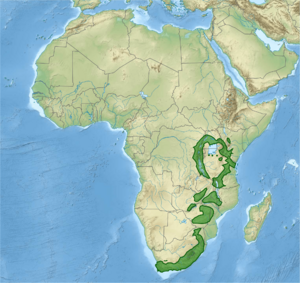 |
|
| Distribution map | |
The White-necked Raven (scientific name: Corvus albicollis) is a type of raven found in eastern and southern Africa. It is a bit smaller than the well-known common raven. It is also smaller than its closest relative, the thick-billed raven. These birds are usually about 50 to 54 centimeters (about 20 inches) long.
Contents
What Does It Look Like?
The White-necked Raven has a shorter tail compared to the common raven. It also has a strong, deep beak with a white tip. This beak is almost as curved as the Thick-billed Raven's beak.
Most of its body is black. However, its throat, chest, and neck have a slight purple shine. You can easily spot a large patch of white feathers on the back of its neck, which is called the nape.
This raven is a great flyer and can soar high in the sky. It flaps its wings less deeply than other birds in the crow family, known as corvids.
Size and Weight
- Length: 50 to 54 centimeters (about 20 to 21 inches)
- Wingspan: 752 to 860 millimeters (about 30 to 34 inches)
- Weight: 762 to 865 grams (about 1.7 to 1.9 pounds)
How It Sounds
People often say the White-necked Raven sounds like a raven with a sore throat! Its calls are very similar to the common raven's, but they sound a bit more rough or "husky." It makes a croaking sound, like other raven species, but it can also have a quieter, whispering note.
Like all corvids, the White-necked Raven can copy sounds it hears. This is called vocal mimicry. However, this amazing behavior has only been seen in ravens that are kept by humans, not in the wild.
Where Does It Live?
You can find the White-necked Raven in eastern and southern Africa. They prefer open areas with mountains or hills. These birds are quite common in small towns and villages. They like to live near places where they can find mountains or hills to rest and build their nests.
What Does It Do?
Most of this bird's food is found on the ground. However, they will also look for food in trees. White-necked Ravens are clever hunters. They have been seen dropping tortoises from high up onto hard ground, especially rocks. After the tortoise shell breaks, they swoop down to eat it. If the shell doesn't break enough, they might even pick it up and drop it again!
These ravens also eat dead animals found on roads, which are called road kills. They enjoy eating fruits, grains, insects, small reptiles, peanuts, and even human food. They are not shy and will often look for food in backyards and gardens.
Like most raven species, young White-necked Ravens form groups after they leave their parents. Once they are fully grown, they will find a partner and create their own territory. You can often see them with other animals that eat dead things, like kites or vultures.
Reproduction and Life Cycle
White-necked Ravens build their nests using sticks. They make a bowl shape and line it with soft materials like grass, animal hair, and wool. They usually build their nests on cliff ledges. Sometimes, though, they will build them in trees. A female raven typically lays 3 to 5 eggs.



